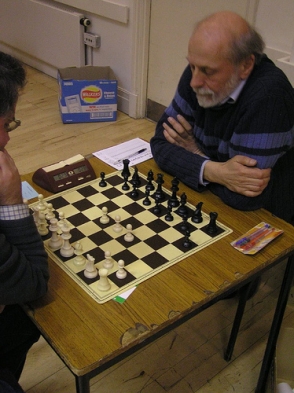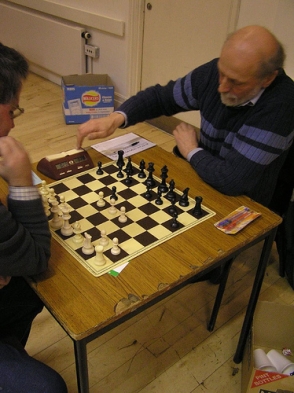Michael Basman en het bizarre II
Het kon natuurlijk niet uitblijven dat mijn korte artikeltje over Michael Basman, de man van de bizarre openingssystemen, een reactie zou krijgen (zie Michael Basman en het bizarre ). Niemand minder dan de “Basman” van de lage landen, IM Gerard Welling, stuurde mij een uitgebreid bericht. Gerard stond erom bekend dat hij in de jaren ’80 veel experimenteerde met onregelmatige openingen. Als speler van de succesvolle ploeg van de Eindhovense schaakvereniging (die in 1984 als enige club de hegemonie van 14 landtitels van Volmac/Rotterdam wist te doorbreken) maakte Welling in één seizoen furore met diverse obscure openingsvarianten. Zo liet hij 1. b3, 1. g4, 1. Ph3 de revue passeren. Toen hij 1. c3 na 1… e5 liet volgen door 2. c4 ontlokte dat een van zijn teamgenoten de opmerking: “geef die man de volgende keer gewoon zwart!”
Welling maakte mij erop attent dat Matthew Sadler zich tijdens het Bevrijdingstoernooi in Wageningen (dat hij met 7 uit 7 op zijn naam schreef) ook al bediend had van Basmansystemen. “Uit een soort nostalgie naar de goede oude Britse schaakwereld”, schrijft Welling die daaraan toevoegt dat volgens hem Sadler na die beginzetten zijn eigen gedachten er op na houdt, maar dat de openingsbehandeling in de partij Van Oosterom-Sadler juist wel weer geïnspireerd was door het spel van Mike Basman, die zijn hand niet omdraait voor zulke frivole pionoffers met …d6.
Additioneel laat Welling weten dat Basman zelf de dubbele randpionopening "the Global opening" noemt om duidelijk aan te geven dat het belang van deze methode iets eenvoudigs als een openingsvariant verre overstijgt. Zelf zei Welling ook al eens "het is geen opening maar een levenswijze" zonder daar overigens een positief etiket op te plakken…

Op de eerste foto is te zien dat Basman 1.e4 h6 2.d4 a6 heeft geopend. Aan het notatiebiljet en de pen zie je dat hij ook groot belang hecht aan rapidpartijen want ze worden in principe bewaard! De witspeler heeft zojuist agressief 3. f4 gespeeld. In Eastbourne 1990, het toenmalige Brits kampioenschap kreeg de zwartspeler dit tweemaal tegen: Simon Bibby werd met 3… c5 bestreden, GM Daniel King met 3… b5.

De tweede foto laat zien dat inzichten veranderen, want daar heeft de zwartspeler net een derde zet gedaan, en dat is niet één van deze twee.
Om alles in een historisch perspectief te plaatsen, wordt duidelijk dat de Brits-Armeense meester in de jaren ‘70 en ‘80 experimenteerde met … b5 (bijv. 1.e4 a6 2.d4 b5) en … g5 (bijv. 1.d4 h6 2.e4 g5) opstellingen. Eerstgenoemde doopte hij St.George’s opening, en … g5 noemde hij de Grob, een naam die door de schaaktheorie al was toegekend aan 1. g4. En in 1990, in het Brits kampioenschap in Eastbourne schokte Basman alle aanwezigen door beide randpionnen op te spelen. Met mogelijke overgangen naar zijn eerdere lijfsystemen maar vooral met een uitnodiging aan de tegenstander:
- bezet het centrum maar, dan val ik het aan, eventueel met behulp van een flankopmars;
- bezet je het centrum niet, jammer dan doe ik het alsnog.
De volgende twee partijen zijn 16 jaar geleden gepubliceerd in de schaakrubriek van de krant "The Independent on Sunday" en geven inzicht in de opmerkelijke denkwereld van Michael Basman. “Het zijn ook nog eens leuke partijen”, schrijft Welling, dus hopelijk doen we bezoekers van Schaaksite hier ook veel plezier mee!
Uit de “Independent on Sunday” de column “Chess” van Michael Basman met de volgende twee partijen:
en van Basman na (met analyses)
Basman – Djuric, Islington Open 1993.
1. h3 [ I call this the ‘Global Opening’. You can play it, as I have done for the past few years, with either colour against anything. ] 1… b6 2. c4
[ Let me explain the Tao of Chess. 1. h3 poses a question: Will you occupy the centre or not? After 1..e5 or d5, I continue 2. a3, giving my opponent freedom to continue his self-expression. But if he evades the issue with a move such as b6, I revert to a more conventional style. ] 2… c5 3. Pc3 g6 4. Pf3 Lg7 5. d3 Pc6 6. e4
[ It’s all part of the feminine side of the Tao: 1. h3 waits for a response, then c4, d3 and e4 negates his b6. Negation is a feminine characteristic. ] 6… d6 7. g4 [This makes h3 look useful, though I could also have played quietly with Be2 and 0-0. ] 7… e6 8. Lg2 Pe5 [He is trying to dominate the Black squares, so I must fight. My reply shows another use for 1. h3. ] 9. Ph2 g5 10. Pf1 Lb7 11. Pg3 Pg6 12. Ph5 Le5 13. Da4+
[ On playing this move, I had a sensation that everything was in place for the Global Immortal Game. Since Qd7 loses the g- pawn, he must move his king. ] 13… Kf8 14. Pe2 Ph4 15. O-O Pxg2 16. Kxg2 d5 17. cxd5 exd5
18. Lxg5 [ More flashy and more effective than 18. f4. ] 18… Dxg5 19. f4 De7 20. fxe5 Td8 [ I must admit my next move was based on a miscalculation, but it didn’t matter. ] 21. Txf7+ Kxf7 [ After 21 . . . Qxf7 22. Rf1 Black’s uncoordinated rooks are no match for the white queen. ] 22. Tf1+ Ke6 [ I had been counting on 22 . . . Kg6 23. Nef4+ Kh6 24. exd5 when Qxe5 is met by 25. h4! with the deadly threat of g5+. Now he threatens Kxe5 and an escape to the Q-side. ] 23. Tf5 Dc7 24. Phf4+ Ke7
25. Pc3! [ He can hardly move anything. 25 . . . dxe4 loses to 26. Qc4 threatening mate on e6 or f7. ] 25… Ph6 26. Tf6 Pf7 [ He could have fought harder with 26 . . . dxe4 since Qc4 would no longer threaten mate on f7. ] 27. Pfxd5+ Txd5 28. Pxd5+ Lxd5 29. exd5 [ Now Qxe5 loses to Re6+. He finds another way to lose quickly, but the white centre pawns are too much to cope with in any case. ] 29… Pxe5? 30. d6+ Dxd6 31. Txd6 Kxd6 32. Dxa7 Pd7 [ and Black resigned at move 40 ] 1-0
Basman – McMichael, Surrey Open 1994.
1. h3 d5 2. a3 e5 3. d3 f5
[The moves h3 and a3 are an invitation for Black to decide what type of game he wants. His pawn advances clearly indicate a desire for a full-blooded struggle. It is time to respond. ] 4. g4! [This pawn sacrifice (which my opponent delays a move before accepting) is logical: Black’s pawn moves have ensured that his king will not be safe in the centre. With the h-file open, it cannot be comfortable on the K-side either. ] 4… c6 5. Lg2 fxg4 6. hxg4 Lxg4 7. Pf3 Pd7 [ With the d-file now blocked, I can play c4 without allowing an exchange of queens. The same would have applied if he had defended e5 with Bd6. ] 8. c4 dxc4 [ Too simple. He should try to maintain his pawn at d5. By exchanging, he abandons control of the important e4 square. ] 9. dxc4 Pgf6 10. Pc3 Dc7
11. Pg5 [ Preventing him from castling Q-side, which could now be met by Nf7. Now his king has trouble finding safety anywhere. ] 11… Pc5 12. Dc2 Pe6 [ Expecting 13. Nxh7 0-0-0, Black overlooks a sacrifice. ]
13. Txh7 Txh7 [ After 13… Nxh7, I had intended 14. Qg6+ Ke7 (Kd8 is met simply by Nf7+ and Nxh8) 15. Nxh7 with an overwhelming position. ] 14. Dg6+ Ke7 [ Again after 14… Kd8 simply Nxh7 is strong. His idea is to lure my queen to f7 where it does not attack g4 or h7 … ] 15. Df7+ Kd8 16. Pxe6+ Lxe6
17. Dxf8+ [ … but it does attack f8. Now 17… Ne8 is met by Bg5+ so he must lose up his rook. ] 17… Kd7 18. Dxa8 Th2 [ Black hopes for a counter-attack based on the relatively unprotected position of my king in the centre, but with my e-pawn and f-pawn unmoved, it’s safe enough. ] 19. Lf3 e4 20. Pxe4 Pxe4 21. Lxe4 Db6
22. Le3 [ It’s White’s attack that hits its target first. There is no defence to the threat of Rd1+. Black resigns. I have often found that giving an opponent a free hand in the centre with 1. h3 and 2. a3 results in over-reaction. In this case d5, e5 and f5 led not to central control, but open spaces and weakness for Black. A proper approach to the centre demands striking a balance between occupation and control from a distance. ] 1-0
Aldus Michael Basman in zijn twee krantenrubrieken. The Independent on Sunday had indertijd een wisselende bezetting voor deze rubriek, ook Tony Miles en Keith Arkell schreven hem met regelmaat.
De derde partij die we willen tonen is een partij (ook met het Engelse commentaar gehandhaafd) uit het blad Chess en dan wel een soort “Raad de zet”-rubriek.
Basman – O’Cinneide, Lloyds Bank Masters 1993.
1. h3 d5 2. a3 e5 3. c4 dxc4 4. e3
[ An excellent move which threatens to recover the pawn at c4 and at the same time develop the bishop at f1. ] 4… Le6 5. Dc2 [ Logical ; White threatens to recover the pawn. ] 5… Pc6
6. Pf3 [White does not wish to capture 6. Lxc4 because after 6… Lxc4 7. Dxc4 Black has the annoying 7… Dg5 8. Dg4 Dxg4 9. hxg4 Pa5] 6… Le7 [After 6… Pa5 7. Pxe5 Pb3 8. Ta2 c3 9. Pxc3 Pxc1 10. Dxc1 Lxa2 11. Pxa2 gives White compensation ( 11… Dd5 12. d4 Dxa2 13. Lc4 )] 7. Lxc4 Lxc4 8. Dxc4 f5
9. d4! [Black’s last move was a reckless advance. The question is how to take advantage of it. 9.d4! opens up the centre to build up an attack. 9. Pc3 allows 9… e4 when after 10. Pd4 Pxd4 11. exd4 White has a weak pawn at d4] [9. Db5 a very promising move, which wins a pawn by attacking b7 and e5. 9… Dd6 [But black can sacrifice a pawn more favourably and gain a lead in development. 9… Lf6! 10. Dxb7 Pge7] 10. Pxe5! Dxe5 11. Dxb7] 9… e4 [White can even afford to sacrifice his centre pawn after 9… exd4 10. exd4 Dd7 11. O-O O-O-O 12. Lf4 as his attack is so powerful.] 10. Pe5 [The most effective continuation, as we shall see. 10. Pfd2 gives Black a chance to regroup after 10… Pf6 11. Pc3 Dd7 and ..0-0-0.] 10… Pxe5 11. dxe5 [ White’s pawn at e5 now prevents the developing move of Black’s knight to f6. ] 11… c6
12. Pc3 [ Slighty better than castling, as you are meant to develop your weaker pieces first. ] 12… Da5 13. De6 [13. b4 is a very powerful sacrifice. If Black takes the pawn at e5 he is in serious trouble after 13… Dxe5 14. Lb2 threatening Na4.. and Bxg7.. On 14… Pf6 15. O-O-O is very strong. White then threatens 16.Nd5! ( 16..cxd5 17.Qb5+ Nd7 18. Bxe5 ). 13.Qe6.. is also very powerful, defending the pawn at e5 and trapping the black king in the middle.] 13… Ph6 14. b4 [ Prepares to complete development. ] 14… Dc7 15. Lb2 Td8
16. O-O [At last ! Now the rooks are connected. But Black’s king is still trapped in the middle of the board. 16. Tc1 has a tactical point in that it threatens 17.Nb5.., but the whole idea is easily met by 16… Dd7 offering a queen exchange.] 16… Td2 17. Tab1 [17. Pa4 is tactically weak as it loses a piece to 17… b5 18. Lc3 Td3] 17… Dd7 18. Db3 [ The queens must be kept on the board. ] 18… Dd3 19. Tbd1 [ White is effectively a rook ahead as Black’s rook is shut out at h8. This move . however , had to be calculated carefully, because of Black’s apparently strong reply.] 19… Dc2
20. De6 [ Another fine move, sacrificing a piece for the attack. ] 20… Dxb2 21. Txd2 Dxd2 22. Td1 [ Brings the rook into action and accentuates White’s advantage. A second piece is sacrificed at c3. ] 22… Dxc3 23. Td7 [ Ties Black up completely with the threat of 24.Qxe7+. After 23.Rd7.. Black has to undevelop the knight at h6, which leaves him in a pitiful position, despite the two extra pieces. ]
23… Pg8 [Black can sacrifice his queen here by 23… Da1+ 24. Kh2 Dxe5+ 25. Dxe5 Kxd7 but after 26. Dxg7 he loses more material.] 24. Txb7 [ Of course. Now Rb8+ is unstoppable. ] 24… Dc1+ 25. Kh2 Dd2 26. Tb8+ Dd8 27. Txd8+ Kxd8
28. Df7 [ The most devastating. Black has a rook and two pieces against the queen, but after this move White will win the black knight after 28..Nh6 29.Qxg7 and Qxh6, when the rook and bishop are no match for the queen and pawns. Black never recovered from his misguided 8..f5. 1-0

